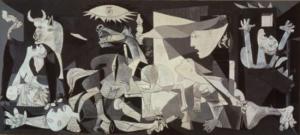The idea began at the Friends Meeting House in Taunton in 1981. 11-year-old Jonathan Stocks felt the room where they held the children’s meeting needed cheering up. Anne was a professional embroiderer who had recently studied the Bayeux Tapestry. She had a vision of a Quaker embroidery - a series of panels each illustrating one event or idea from Quaker history. Each panel would be made (researched, designed and embroidered) by a different Meeting or group, but she would oversee the design…
Stephenson, Roger
Stephenson, Roger
Roger Stephenson
From the first, the Quakers have taken a clear stand for peace and against military action. In 1660, soon after the movement’s founding, Margaret Fell, the Mother of Quakerism, gave her testimony: “We are a people that follow after those things that make of Peace, Love and Unity.”
The Quaker Tapestry, displayed in the Quaker Tapestry Exhibition Centre, tells the history of Quakerism. A new exhibition, Weapons of the Spirit, has been created in a small space within the main exhibition…
In Paris, Dora Maar was in tears and Picasso had found the subject for the painting he had been commissioned to do by the Spanish republican government for the Spanish pavilion at the international exhibition that was due to open in the French capital in May. With time running out, the exhibition finally opened on the 1900 exhibition site between the Champs de Mars and the Trocadero in June. The Spanish pavilion was not ready until July.
Picasso worked quickly with an intense fury of…
As a child William Morris lived near Epping Forest, a place he would later describe as “always interesting and always beautiful”.
Kathy Haslam, curator of Blackwell and co-curator of this exhibition with Helen Elletson, curator of Kelmscott House, sees Morris’s sense of place as a thread running through his life and work. The exhibition tries to show how important place was to him. It looks at the successive places where he lived and worked and shows the logical development from his…
I stand for life against death. I stand for peace against war! – Pablo Picasso
“Picasso Peace and Freedom” at the Tate Liverpool looks at Picasso’s work between 1944, when he joined the French Communist Party, and his death in 1973. It shows him as an artist who recorded the brutality of war and worked through his art, and in his life, for peace.
The exhibition, curated by Lynda Morris of Norwich University College of the Arts and Christoph Gruneberg, director of Tate Liverpool…
The idea began at the Friends Meeting House in Taunton in 1981. 11-year-old Jonathan Stocks felt that the room where they held the children’s meeting needed cheering up. He discussed it with their teacher, Anne Wynn-Wilson. They needed pictures. Why not a history of Quakerism in collage or mosaic? Or embroidery?
Anne was a professional embroiderer. She had recently completed a study of the Bayeux Tapestry, which is not really a tapestry but a 70-metre-long strip of linen embroidered…
In October 1916, the German artist Käthe Kollwitz wrote in her diary: “It’s not only our youth who go willingly and joyfully into the war; it’s the same in all nations. People who would be friendly under other conditions now hurl themselves at one another as enemies.” All she could see in the war was “criminal lunacy”. “I have been thinking,” she wrote later, “whether I could not contribute something to the propaganda for peace.”
Kollwitz was born in 1867 into a family with a…
Ten Tiny Toes looks at the impact of the wars in Iraq and Afghanistan on the families who have sons and daughters serving there.
Like every mother, Gill wants the best for her sons. Raise them well, keep them safe, clean and out of trouble. But for Michael and Chris the choices are few and far between. The only way to have the best and be the best is to join the army.
The play opens with a montage of news footage on a screen that forms the whole of the backdrop to the stage.…


